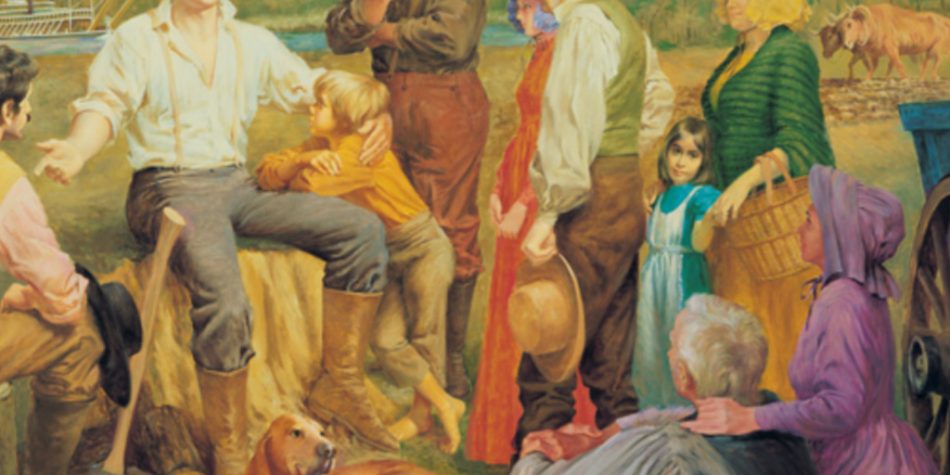In her book, The New Religious Intolerance, Martha Nussbaum has written that “any self-knowledge worth the name tells you that others are as real as you are, and that your life is not just about you, it is about accepting the fact that you share a world with others, and about taking action directed at the good of others.”
In this special series in Public Square Magazine, we share religious and relational strengths from eight religious-ethnic communities (Asian Christian, Black Christian, Catholic and Orthodox Christian, Evangelical Christian, Jewish, Latter-day Saint, Mainline Protestant, and Muslim). Part of what we share in each article is our own sense of deep respect—and even holy envy—about various aspects of faiths other than our own.
We are professors of family life at BYU and co-directors of the American Families of Faith project. In this article, consistent with articles on the other seven religious-ethnic communities, we share a few quotes drawn from those whom we interviewed. In this essay the quotes center on the eternal nature of life, marriage, and families from persons from our own faith, The Church of Jesus Christ of Latter-day Saints (aka The Church of Jesus Christ, LDS, Mormon).
In this essay we turn to our own faith, not to brag but to share a pronounced strength of this faith (to which Dave converted at age 19 and in which Loren was raised). After we share brief narratives from members of some of the 28 LDS families we have interviewed, we will discuss the idea of holy envy, share some thoughts on LDS family life from some respected scholars from various disciplines who are not LDS, and conclude with a few thoughts about the things that we personally find most meaningful about our own faith.
Eternal Perspectives
The 28 LDS families we interviewed (28 husbands, 28 wives, 11 youth) were from seven states and, on average, were in their mid-40s and had been married about 20 years. All 28 families mentioned the eternal nature of the family as a key component driving family relations.
A mother named Bailey shared,
When our daughter died, you know the whole thing about the normal steps [of grieving] … you should go through? One being anger. … Well, I was not angry. … I had this faith. I didn’t understand it, but … both of us had extraordinary peace. That doesn’t mean you don’t cry, it doesn’t mean you don’t suffer … [but] there was this faith, there’s this basic faith that it was in God’s hands. … I don’t … look at trials and say, “Why me?” That’s useless, totally useless. [A better question to ask is] “What can I learn?”
Benton, an African American husband and convert to Mormonism said,
And [LDS missionaries] came in, and we sat on the floor, I was a [divorced], single man at that time, and … I looked them in the eyes. There were two sisters … and they told me about the plan of salvation, and I learned [about] the preexistence, about being with our Heavenly Father before the world was, … and that I was sent to Earth to … learn, to grow, and to really understand what my purpose … really is. Once [I] learned it, [and] got the point … I made a commitment. … I knew what they were telling me, was right and true.
Cynthia, a 15-year-old Latina daughter said,
[L]ooking at the big picture … God promised us that if we get married in the temple and have a family who’s sealed in the temple and you’re sealed to somebody [then that is forever]. … [Y]ou have somebody who’s going to be with you … all the way, a companion that you have married in the temple that’s going to want to … be righteous through [time and eternity].
Allie, a wife, said,
Believing in families being forever is really the core. … It’s not just, “I’m in it for me,” or even, “I’m in it for a spouse.” We are in it forever. It makes [marriage] … so much more important knowing [it is] … forever and not just until the kids leave the house.
One husband said:
I [also] strongly believe in the concept of eternal progression—that once I die there’s something that’s going to happen to me. … [W]e believe that marriage is eternal. That means that when I die … I continually will progress with my wife. I think it’s one of the things, that even in the times that we struggled … [that] … has kept me [gr]ounded in the fact that … divorce … for me … was never really an option. When I decided to get married, it was to someone who I felt was worth the work to stay with forever.
A father named Don said,
We talked earlier about th[e] concept of eternal progression and that my wife and I can be together forever. … In the same aspect by doing this [unifying temple] work for our own families and other families, we have th[e] potential of being together as families forever, not just my wife and I, but my wife and my children and my grandparents, my parents, their parents, and so on and so forth. By accomplishing this work, through our beliefs, we’re able to accomplish that strength, that family unity.
Alecia, a 20-year-old Latina daughter, said,
Knowing that we are going to be together forever, that we’ve been sealed as a family, that we are bound forever, [that] we have that bond—it’s like fighting … seems trivial when you think about it. … When someone has a problem, you’re more willing to help them because you know you’re going to spend eternity with that person and you’re going to love them—whether or not you like it. … And most of the time you do, but it just makes it [easier, during] the hard times, to get through it.
These few quotes are supplemented by a number of others in the full article. For Latter-day Saints, the doctrine that marriage and family life can be perpetuated beyond the grave is a central part of the restored gospel of Jesus Christ. This teaching brings peace, joy, comfort, and hope in the midst of a world of change, decay, death, sadness, and loneliness.
Of course, Latter-day Saints do not have a monopoly on ideas and yearnings around the eternal nature of the soul, of romantic love, and of marriage and family relationships. Such ideas abound in domains as disparate as select rock and roll music and the teachings of other world religions. For example, Orthodox Christian (aka Eastern Orthodox) theology includes the teaching that since it is God that marries persons and since God is eternal, marriage is also eternal. Islamic teachings include the idea of family life in paradise. Jehovah’s Witnesses teach that Witnesses who are married when Jesus returns will remain married in the New Order of Things. For Latter-day Saints, the doctrine that marriage and family life can be perpetuated beyond the grave is a central part of the restored gospel of Jesus Christ.
When a couple kneels across an altar in a sealing room in a temple, they face each other and join hands and are then sealed “for time and all eternity” by the power of the holy priesthood. This can bring a sense of profound security brought on by belief in relational permanence, in the midst of increasing relational instability and general anxiety all around them.
When a family converts to the Church of Jesus Christ, they are able to kneel together around an altar, join hands, and be sealed as a family for time and all eternity. Children born to couples who have been sealed are “born in the covenant” and are considered sealed to their parents for time and all eternity as they honor sacred promises made to God and each other. Again, the sense of personal and relational security that is possible from these actions is real and powerful.
LDS Prophets Urge Church Members to Learn from Other Faiths
Some from our own faith as well as those from other faiths may wonder why a couple of committed, active Latter-day Saints like ourselves have devoted more than two decades together studying other faiths and highlighting the virtues and strengths about those faiths and those who earnestly strive to live them.
It is not that we have neglected to study families from our own faith. In fact, we have published articles and a few books about LDS marriage and family life. But we have devoted even more time and energy to studying and publishing about our friends of other faiths. Why? The simple answer is that, based on the teachings of Latter-day prophets, we believe it is a religious duty for Latter-day Saints to strive to learn truth from any and all sources, including from other faiths.
The founding prophet and president of The Church of Jesus Christ of Latter-day Saints, Joseph Smith said, “I have the most liberal sentiments, and feelings of charity towards all sects, parties, and denominations” and “When we see virtuous qualities in men, we should always acknowledge them, let their understanding be what it may in relation to creeds and doctrine.” He also taught, “There is a tie from God that … enables us to conduct ourselves with greater liberality toward all others that are not of our faith.”
The second president of the Church, Brigham Young, said “It is our duty and calling … to gather every item of truth and reject every error. Whether a truth be found with professed infidels, or with the Universalists, or the Church of Rome, or the Methodists, the Church of England, the Presbyterians, the Baptists, the Quakers, the Shakers, or any other of the various and numerous different sects and parties, all of whom have … truth.”
In speaking about our friends of other faiths, recent church president Gordon B. Hinckley stated, “Look for their strengths and their virtues, and you will find strength and virtues that will be helpful in your own life.”
We could provide other similar quotations but hope that these demonstrate a truth that invites and even urges Latter-day Saints to gather and live truth from any and all sources including from other faiths. We have learned that doing so can result in profound respect and admiration for other faiths and for those who practice them.
Holy Envy
One of our intellectual and religious heroes from whom we have learned much is Krister Stendahl. Stendahl was Dean of the Harvard Divinity School and then Lutheran Bishop of Stockholm (Sweden). While serving as Bishop of Sweden, Stendahl held a press conference in response to the strong and swelling public opposition to The Church of Jesus Christ of Latter-day Saints building a temple in Stockholm.
In that press conference, Bishop Stendahl wisely and compassionately mentioned the three rules he tries to follow when dealing with other faiths: (1) ask adherents of a faith, not their enemies, what they believe, (2) be sure to compare “bests” with “bests” of faiths you are comparing (not bests of one faith with worsts of another), and (3) try to leave room for holy envy, meaning a deep appreciation of the good qualities of other faiths that you admire so much you might even wish they were part of your own faith. For example, he mentioned that he had holy envy for the LDS practice of baptism for the dead.
While we have written elsewhere about how we experience holy envy for other faiths, the following are just a few aspects of other faiths for which we experience holy envy:
We have written about the LDS practice of Family Home Evening for both our scholarly colleagues and for a popular audience. We ourselves have participated in literally thousands of Family Home Evenings in our own families. Nevertheless, we are on record as calling Jewish Shabbat (Sabbath) observance, “the weekly family ritual par excellence.” Because we admire this sacred practice so much, we have written brief articles for our fellow Latter-day Saints suggesting how we might learn from our Jewish friends (see articles in the LDS Church News and Meridian Magazine).
We are glad to participate in our own faith’s practice of monthly fasting for 24 hours and donating at least the amount of money of the food that would have been eaten to help alleviate the suffering of those in need. We also are on record in expressing our profound admiration for the Muslim practice of fasting for 30 days during the month of Ramadan and the practice of zakat (contributing 2.5% of one’s net worth to charity).
We love and appreciate our own faith’s teaching that regular personal, couple, and family prayer are important and have tried to maintain the practice of regular personal and relational prayers. We also have worked to explore and write about the ways that families of various faiths are benefitted by regular relational prayer.
We appreciate and admire the ways that our fellow Latter-day Saints have weathered opposition and challenges as members of a frequently misunderstood minority faith. In addition, we have written about our deep respect for how, through deep and abiding religious belief and belonging, Black Christians in America have weathered hundreds of years of prejudice and oppression.
We admire and have benefitted from the way that LDS communities care for each other, help each other move in and move out, and help fellowship each other through tough times and challenging changes. We also have written about the ways that our Asian Christian friends who have left their home countries and converted to a new faith (Christianity) endeavor to embrace each other and help each other, including meeting new immigrants at the docks, bringing them into their homes, and creating a “church family” that cares for the total person. Our own faith’s teaching that regular personal, couple, and family prayer are important.
As we sat with, interviewed, and learned from families of various religious, ethnic, racial, and cultural communities across the United States, we often found ourselves feeling great kinship with them. We found that we enjoyed great commonalities of devotion to God, loyalty to a faith community, and desire to serve God and our fellow human beings. We also have experienced deep resonances between other faiths’ theologies and sacred practices and LDS doctrine and sacred ordinances, most particularly with temple ordinances. For example, one commonality is the use of the right hand in religious ceremonies.
Something that nearly all faiths have in common is the use of religious art and sacred objects. Loren refers to Dave’s BYU office as a “gallery of religious art and artifacts.” Dave’s office includes books and religious objects from his own faith (e.g., various paintings of Jesus, a bust of Joseph Smith, a statue of the Angel Moroni, and a replica of a Sunstone from the Nauvoo Temple). It also contains books and religious objects from many faiths: a Jewish menorah, mezuzah, shofar, dreidel, and prayer shawl; three Orthodox Christian icons of Christ, a Muslim prayer rug, three Catholic rosaries, three statues of Hindu deities, a Tibetan Buddhist singing bowl, a Hopi Morning Singer Kachina Doll, and a wood carving of a laughing Buddha that belonged to his mother. Life is richer when we honor and respect the sacred views of others, whether they align fully with ours or not.
Non-LDS Scholars on Latter-day Saint Life
We are grateful that a number of respected scholars of various faiths and disciplines have paid the price to study and understand the LDS faith to such a degree their insights are helpful and meaningful to Latter-day Saints. They have made important contributions to the understanding of LDS life including family life. Here are a few brief examples:
Jan Shipps, a Methodist historian who became one of the preeminent scholars of the field of Mormon history, in her book called Sojourner in the Promised Land: Forty Years among the Mormons shares her deep and abiding interest in LDS history. She strived to understand the LDS experience as a friendly outsider.
A leading sociologist of religion, Rodney Stark, in his book The Rise of Mormonism, illustrates his open-minded and scholarly approach to the data that allowed him to document the growth of the Latter-day Saints from a tiny, obscure faith in 1830 to what he calls “a new world faith.”
The late Stephen Webb, a Catholic religious studies scholar, engaged in profound study of LDS belief and practice that led him to write a fascinating book called Mormon Christianity: What Other Christians Can Learn from the Latter-day Saints in which he does a deep dive into how a number of elements of LDS theology might assist Christians from various faiths to reconsider aspects of their theologies in important ways.
University of Southern California sociologist, the late Vern Bengtson, and colleagues have reported in their book, Families and Faith: How Religion is Passed Down across Generations, based on a landmark, four-generation study of religion and family life,
The most successful programs fostering intergenerational connections and the nurturing of families have been instituted by Mormons, of which a prime example is their Family Home Evening [on] Monday nights. The LDS parents and bishops we spoke with attributed the success of their faith in religious transmission to activities such as this [Family Home Evening] that integrate family and faith and emphasize family growth and development (pp. 202-203).
Douglas Davies, a British, non-LDS religious studies scholar, in his book The Mormon Culture of Salvation, provides a thorough and accurate exploration of LDS doctrines on eternal marriage, eternal families, and eternal exaltation (what Davies calls “Mormon super salvation”).
Kenda Creasy Dean, a professor of Youth, Church, and Culture at Princeton Theological Seminary (and an ordained United Methodist pastor), in her wonderful book, Almost Christian: What the Faith of Our Teenagers is Telling the American Church, wrote a deeply respectful and well-informed chapter called “Mormon Envy: Sociological Tools for Consequential Faith” in which she reported findings from the National Study of Youth and Religion that indicate that LDS youth tend to do very well on a number of outcomes.
From Stendahl and Shipps to Davies and Dean, we appreciate the efforts of these various “outsider” scholars to study, understand, and discuss our faith—from family home evening to the temple-based efforts to help marriages and families last forever. Even more than this, we respect the religious tolerance, dignity, respect, and holy envy that these diverse sisters and brothers in the human family model. May we graciously receive their “lived invitation” to the rest of us to do likewise.
About the Authors: While we ourselves are active (devoted) members of The Church of Jesus Christ of Latter-day Saints, in our work in the American Families of Faith project, we seek to highlight the strengths of our friends of various faiths. We have developed a sense of deep respect and even holy envy for these families and their faiths. Additionally, the book chapters from which these articles are adapted included two coauthors who are devoted members of those faiths.
If you like listening to audiobooks and podcasts, we have recorded a set of conversations about the families we interviewed that includes additional quotes from mothers, fathers, and youth, more of our experiences in attending their services, as well as personal experiences with friends of other faiths. These podcasts are available at:

















